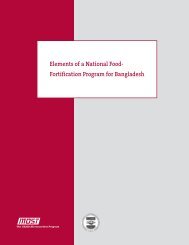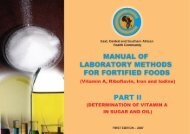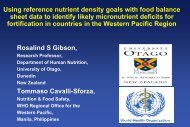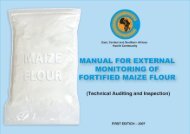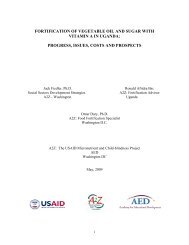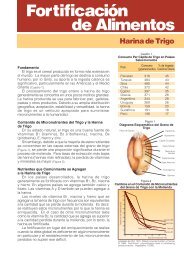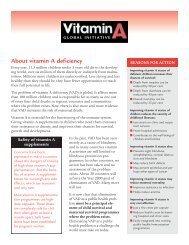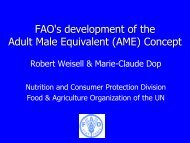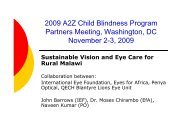manual of methods for determining micronutrients in fortified foods
manual of methods for determining micronutrients in fortified foods
manual of methods for determining micronutrients in fortified foods
Create successful ePaper yourself
Turn your PDF publications into a flip-book with our unique Google optimized e-Paper software.
I. Introduction<br />
Food <strong>for</strong>tification is one <strong>of</strong> the nutritional <strong>in</strong>terventions used to improve the dietetic <strong>in</strong>take <strong>of</strong><br />
<strong>micronutrients</strong> by the population. Typical <strong>foods</strong> <strong>for</strong>tified around the world are cereal flours, ma<strong>in</strong>ly<br />
wheat and maize flours, pasta and noodles, milk, oil and margar<strong>in</strong>es, among others.<br />
Wheat flour <strong>for</strong>tification is carried out <strong>in</strong> many countries around the world to provide vitam<strong>in</strong>s and<br />
m<strong>in</strong>erals through bread, pasta and other bak<strong>in</strong>g goods. The Palest<strong>in</strong>ian Wheat Flour Fortification<br />
Standard issued <strong>in</strong> 2005 establishes that wheat flour must be <strong>for</strong>tified with iron, z<strong>in</strong>c, vitam<strong>in</strong> A,<br />
vitam<strong>in</strong> D, thiam<strong>in</strong> (B 1<br />
), rib<strong>of</strong>lav<strong>in</strong> (B 2<br />
), niac<strong>in</strong> (B 3<br />
), pyridox<strong>in</strong>e (B 6<br />
), folic acid (B 9<br />
) and vitam<strong>in</strong> B 12<br />
.<br />
The micronutrient <strong>for</strong>mulation <strong>for</strong> wheat flour <strong>in</strong> other countries usually <strong>in</strong>cludes only iron, thiam<strong>in</strong>,<br />
rib<strong>of</strong>lav<strong>in</strong>, niac<strong>in</strong> and folic acid.<br />
Food <strong>in</strong>dustry plays an essential role <strong>in</strong> food <strong>for</strong>tification, s<strong>in</strong>ce the food plants and, <strong>in</strong> this case, wheat<br />
mills are responsible to add the m<strong>in</strong>erals and vitam<strong>in</strong>s premix to the flour <strong>in</strong> the adequate amounts to<br />
comply with the requirements <strong>in</strong>dicated <strong>in</strong> the Standard. On the other hand, the M<strong>in</strong>istry <strong>of</strong> Health<br />
verifies that the Standard requirements are be<strong>in</strong>g complied, through <strong>in</strong>spection and sampl<strong>in</strong>g. Samples<br />
are analyzed <strong>in</strong> the Central Public Health Laboratory (CPHL) and reports <strong>in</strong>dicate whether the samples<br />
complied with the Standard.<br />
Vitam<strong>in</strong>s analysis is expensive, because the procedures are long, require sophisticated equipment,<br />
reagents and materials, and skilled and tra<strong>in</strong>ed personnel. Iron analysis is cheaper compared to vitam<strong>in</strong><br />
analysis and this micronutrient is usually used as “Indicator” <strong>of</strong> compliance <strong>for</strong> <strong>for</strong>tification tak<strong>in</strong>g <strong>in</strong>to<br />
account that the same premix conta<strong>in</strong>s all the vitam<strong>in</strong>s and m<strong>in</strong>erals. However, analyz<strong>in</strong>g vitam<strong>in</strong>s is<br />
important to confirm compliance with the standard and not only with iron. This is especially important<br />
<strong>for</strong> flour imported from Israel and other countries, where wheat flour <strong>for</strong>tification is not mandatory or the<br />
micronutrient <strong>for</strong>mulation does not <strong>in</strong>clude all the <strong>micronutrients</strong> specified <strong>in</strong> the Palest<strong>in</strong>ian Standard.<br />
Furthermore, it is important to test the flour and not only the micronutrient premix with the purpose <strong>of</strong><br />
verify<strong>in</strong>g that <strong>in</strong>deed the right premix is be<strong>in</strong>g used <strong>for</strong> the <strong>for</strong>tification <strong>of</strong> the flour.<br />
This Manual presents the <strong>methods</strong> applied <strong>in</strong> the Central Public Health Laboratory <strong>for</strong> the analysis <strong>of</strong><br />
wheat flour and <strong>for</strong>tified <strong>foods</strong>. Although vitam<strong>in</strong> analysis is not applied rout<strong>in</strong>ely due to the cost, it may<br />
be applied periodically to random samples. Moreover, these <strong>methods</strong> are important <strong>for</strong> complet<strong>in</strong>g and<br />
updat<strong>in</strong>g food composition tables based on unique Palest<strong>in</strong>ian dishes.<br />
- 5 -





